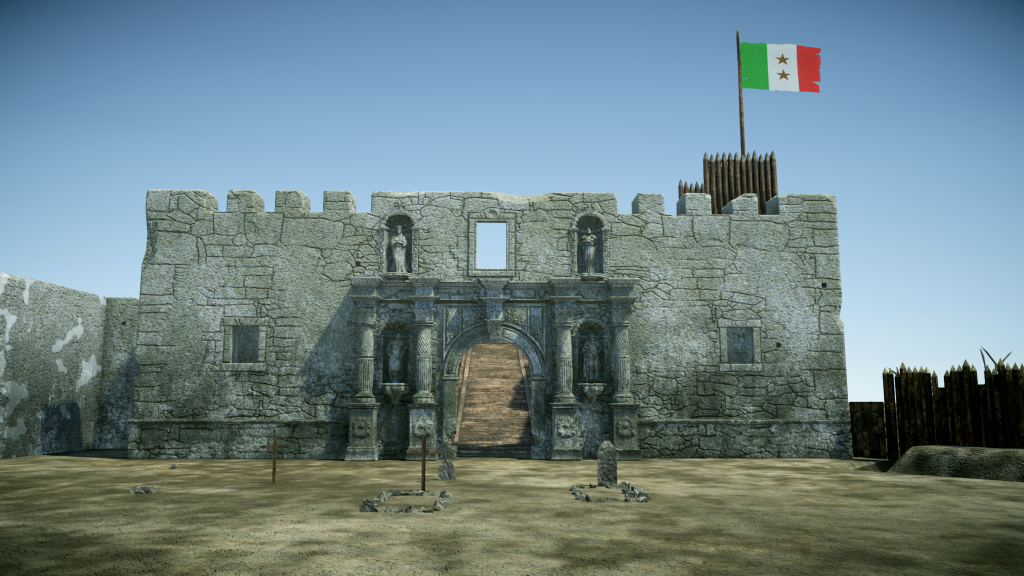
Editor’s Picks
Experience the Alamo Like It’s 1836 with Alamo Reality’s New AR App
By Henry Kronk
April 17, 2018
Visitors to the historic site of the Alamo in San Antonio, Texas have long sought to escape the present and place themselves into a moment of history. But it’s easy to forget that the structure that currently stands isn’t the real thing.
“A lot of the movies and things show the Alamo church as kind of beaten up and rumpled down,” said Michael McGar, President of Alamo Reality. “After the battle, Santa Anna had a general stay behind and destroy the building and the fort itself so that it couldn’t be used again. But all the drawings and photographs, and particularly photographs, which didn’t exist at that time, they show the Alamo beat up like that.”
But now there’s a way that visitors can explore the old church the way it was. Or, at least they can come close. McGar and his team at Alamo Reality have spent the last year recreating the Alamo in 3D to be viewed in an augmented reality mobile app.
“If you’re standing at the Alamo,” McGar said, “and you choose the location where Crockett defended the Alamo, you’re standing there, you look on your iPad, your phone, and you see a portal pop up on your screen. There’s a doorway into 1836.”
McGar’s History with the Alamo
It all started when McGar was chatting with his colleague Leslie Komet Ausburn.
“Back in ’94, ’95, I built a CD-ROM set about the Alamo and we were the first production company to shoot inside the Alamo since 1906. We created a virtual Alamo,” McGar said. Ausburn encouraged him to do it again, but with more modern technology. At first McGar was skeptical.

“I said, ‘Oh well it’s really hard, it was a very hard thing to do.’ [Ausburn] said, ‘Well, if you did it again, how would you do it?’ And I said, ‘Well Pokemon Go just came out, imagine if you could stand at the Alamo and watch Davy Crockett defend his position at the same spot where he did, where he fought in the battle.’ And she goes, okay you’ve got to do it. That’s it. So, we kind of put things together, went out and found funding and built it.”
For the 3D design of the fort, McGar and his company hired Gary Zaboly. “He’s famous for knowing the Alamo better than anyone else and having drawn images of the Alamo for decades,” McGar said. “His drawings, actually, are on the placards surrounding the Alamo to explain what the Alamo looked like in 1836. He has direct source material down to writings and drawings of the Alamo at the time period, and that’s where we got our inspiration and our facts. He found a drawing of one of the captains who was in the battle, a drawing of the building exactly as it was during the battle, and that’s what we used for our understanding of the battle. There were crenellations at the top of the church, like an old medieval fort with the square blocks at the top. It looks totally different than what most people think it looks like.”
“Additionally we have Dr. Stephen Hardin who is a historian who’s written multiple books about the Texan revolution and also about the Alamo and his writings and his research down to original documents. We always go back to original documents, original evidence, and archaeological digs. We aren’t taking stories from John Wayne movies.”
How it Works
You download the app and open it up. As you travel around the site, different portals will appear. “The application has about eleven hours of content in it, so it’s not a small thing.” These eleven hours include perspectives from Texans, African Americans, Spaniards, the French, the Chicanos, and Indigenous Americans.
“If you’re on the Alamo grounds, there’s fourteen different locations that you can see the fort itself, and then you can also see the battle happen. Each of those locations, though, has content underneath that location, so you can see biographies of the people who were at that location, you can see additional movies about what happened at that location, and sometimes there are stories that happened at that location, it isn’t just what happened during the battle, things that happened before the battle, several different types of stories that are really interesting, that you wouldn’t get otherwise, standing at the Alamo.”
You can also use the app without visiting San Antonio. To help with off-site use, Alamo Reality has developed a small, map which will be available next month. View the map through the app on your phone, and a small scale model of the Alamo will display in 3D. The company is also currently developing trading cards of historic figures. These figures also will display in 3D with the app and even interact with one another when placed in close proximity.
A New Way to Explore Historical Sites
In terms of AR in education, Alamo Reality’s app is the first of its kind. “I mean generally speaking with AR,” McGar said, “everybody gets excited if you look through your camera and see something in the foreground wiggling. But to tell full-blown stories and to take somebody into the amount of content and the amount of depth that we have, that is unprecedented. When we first started to do it, it was like, can we really do this? Nobody’s done it, there’s a lot to do, and we sat down with our technical team and we figured it out.”
“As a former college professor, I honestly think this is going to change education. The engagement level, the ability for kids to choose, you don’t have to be at the Alamo to have that experience of the portal. You can walk through a portal anywhere in the world. If you’re at the Alamo, you get the added pleasure of standing at the spot where it happened, but I can also walk through the Alamo every day in my backyard. I just go and I click on the spot where I want to see and I walk right into it. And so I can see kids exploring that and finding things that they never would have thought about. It’s all at full scale. So if I’m standing next to a wall that’s 23 feet high, you look up 23 feet up to see the top of that wall. It’s astounding.”









No Comments